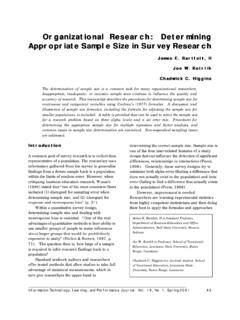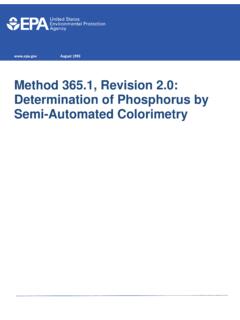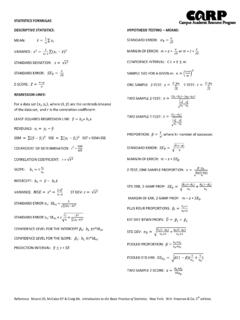Transcription of SAMPLE SIZE DETERMINATION IN HEALTH STUDIES
1 SAMPLE size DETERMINATION IN HEALTH STUDIES A Practical Manual s. K. Lwanga Epidemiological and Statistical Methodology World HEALTH Organization Geneva, Switzerland and S. Lemeshow Division of Public HEALTH University of Massachusetts at Amherst MA USA World HEALTH Organization Geneva 1991 WHO Library Cataloguing in Publication Data Lwanga, S K. SAMPLE size DETERMINATION in HEALTH STUDIES ' a practical manual 1 Sampling STUDIES surveys I. Lemeshow, S ISBN 92 4 154405 8 (NLM Classification WA 950) World HEALTH Organization 1991 Publications of the World HEALTH Organization enjoy copyright protection in accordance with the provisions of Protocol 2 of the Universal Copyright Convention. For rights of reproduction or translation of WHO publications, in part or in toto, application should be made to the Office of Publications, World HEALTH Organization, Geneva, Switzerland.
2 The World HEALTH Organiza-tion welcomes such applications. The designations employed and the presentation of the material in this publication do not imply the expression of any opinion whatsoever on the part of the Secretariat of the World HEALTH Organization concerning the legal status of any country, territory, city or area or of its authorities. or concerning the delimitation of its frontiers or boundaries. The mention of specific companies or of certain manufacturers' products does not imply that they are endorsed or recommended by the World HEALTH Organization in preference to others of a similar nature that are not mentioned. Errors and omissions excepted, the names of proprietary products are distinguished by initial capital letters.
3 The authors alone are responsible for the views expressed in this publication. Typeset In India Printed In England 89/8087 -Macm ,llan/Clays-5000 Contents Introduction Vll One- SAMPLE situations 1 Estimating a population proportion with specified absolute preclslOn Estimating a population proportion with specified relative preClSlon 2 Hypothesis tests for a population proportion 3 Two- SAMPLE situations 6 Estimating the difference between two population proportions with specified absolute precision 6 Hypothesis tests for two population proportions 7 Case-control STUDIES 9 Estimating an odds ratio with specified relative precision 9 Hypothesis tests for an odds ratio 10 Cohort STUDIES 12 Estimating a relative risk with specified relative precision 12 Hypothesis tests for a relative risk 13 Lot quality assurance sampling 15
4 Accepting a population prevalence as not exceeding a specified value 15 Decision rule for "rejecting a lot" 15 Incidence-rate STUDIES 17 Estimating an incidence rate with specified relative precision 17 Hypothesis tests for an incidence rate 17 Hypothesis tests for two incidence rates in follow-up (cohort) STUDIES 18 Definitions of commonly used terms 21 Tables of minimum SAMPLE size 23 1. Estimating a population proportion with specified absolute preclslOn 25 2. Estimating a population proportion with specified relative preClSlon 27 3. Hypothesis tests for a population proportion 29 4. Estimating the difference between two population propor-tions with specified absolute precision 33 iii SAMPLE size DETERMINATION 5.
5 Hypothesis tests for two population proportions 36 6. Estimating an odds ratio with specified relative precision 42 7. Hypothesis tests for an odds ratio 50 8. Estimating a relative risk with specified relative precision 52 9. Hypothesis tests for a relative risk 60 10. Acceptjng a population prevalence as not exceeding a specified value 63 11. Decision rule for "rejecting a lot" 69 12. Estimating an incidence rate with specified relative precision 72 13. Hypothesis tests for an incidence rate 73 14. Hypothesis tests for two incidence rates in follow-up (cohort) STUDIES (study duration not fixed) 77 iv Preface In many of WHO's Member States, surveys are being undertaken to obtain information for planning, operating, monitoring and evaluating HEALTH services.
6 Central to the planning of any such survey is the decision on how large a SAMPLE to select from the population under study, and it is to meet the needs of HEALTH workers and managers responsible for making that decision that this manual has been prepared. It is essentially a revised and expanded version of a popular unpublished document on SAMPLE size that has been widely used in WHO's field projects and training courses. The examples and tables presented, which have been selected to cover many of the approaches likely to be adopted in HEALTH STUDIES , will not only be of immediate practical use to HEALTH workers but also provide insight into the statistical methodology of SAMPLE size DETERMINATION . The authors would like to thank Dr B.
7 Grab, formerly Statistician, WHO, Geneva, Dr R. J. Hayes, London School of Hygiene and Tropical Medicine, and colleagues in the Unit of Epidemiological and Statistical Methodology, the Diarrhoeal Diseases Control Programme and the Expanded Programme on Immunization of WHO for their comments. The financial support of the UNDP/World Bank/WHO Special Pro-gramme for Research and Training in Tropical Diseases is gratefully acknowledged. v Introduction Among the questions that a HEALTH worker should ask when planning a surveyor study is "How large a SAMPLE do I need?" The answer will depend on the aims, nature and scope of the study and on the expected result, all of which should be carefully considered at the planning stage.
8 For example, in a study of the curative effect of a drug on a fatal disease such as the acquired immunodeficiency syndrome (AIDS), where a single positive result could be important, SAMPLE size might be considered irrelevant. In contrast, if a new malaria vaccine is to be tested, the number of subjects studied will have to be sufficiently large to permit comparison of the vaccine's effects with those of existing preventive measures. The type of "outcome" under study should also be taken into account. There are three possible categories of outcome. The first is the simple case where two alternatives exist: yes/no, dead/alive, vaccinated/not vaccinated, existence of a HEALTH committee/lack of a HEALTH committee.
9 The second category covers multiple, mutually exclusive alternatives such as religious beliefs or blood groups. For these two categories of outcome the data are generally expressed as percentages or rates. The third category covers continuous response variables such as weight, height, age and blood pressure, for which numerical measurements are usually made. In this case the data are summarized in the form of means and variances or their derivatives. The statistical methods appropriate for SAMPLE size determi-nation will depend on which of these types of outcome the investigator is interested in. Only once a proposed study and its objectives have been clearly defined can a HEALTH worker decide how large a SAMPLE to select from the population in question.
10 This manual is intended to be a practical guide to making such decisions. It presents a variety of situations in which SAMPLE size must be determined, including STUDIES of population proportion, odds ratio, relative risk and incidence In each case the information needed is specified and at least one illustrative example is given. All but one example are accompanied by tables of minimum SAMPLE size for various study conditions so that the reader may obtain solutions to problems of SAMPLE size without recourse to calculations (more extensive tables are available in the publication by Lemeshow et al. mentioned below). Random sampling is assumed for all examples, so that if the SAMPLE is not to be selected in a statistically random manner the tables are not valid.




